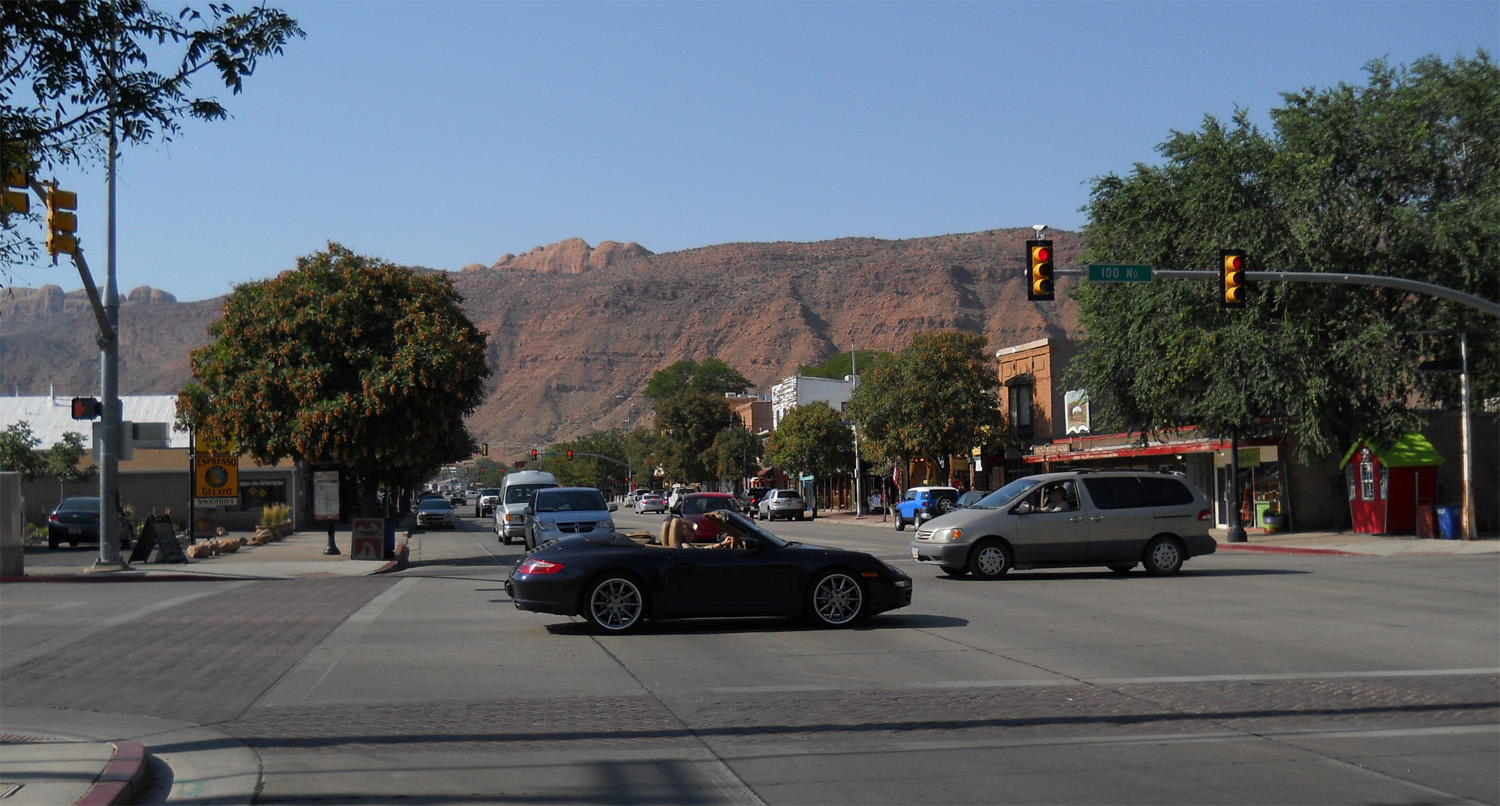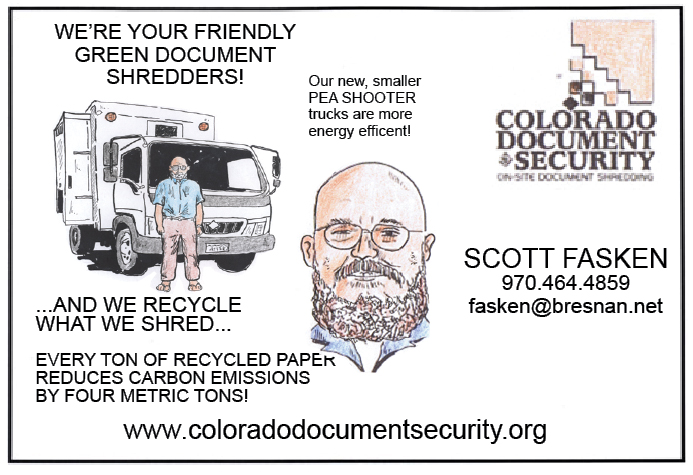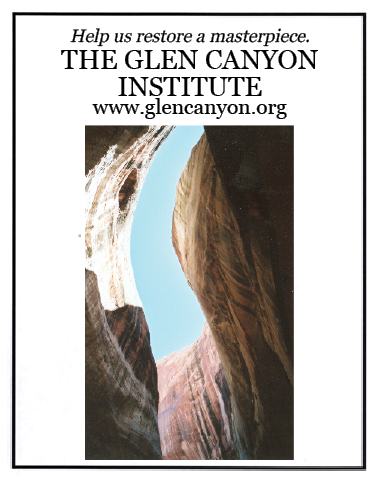The numbers are in. Moab is growing. Judging by the sound of circular saws and hammers echoing around town these days commercial and residential construction projects valued at over $19 million are underway. Moab will add 300 hotel rooms over the next two years, yet another condo complex, road widening and parking improvements throughout Arches and a bicycle trail along the river. Remember these headlines from last year? Coming soon; a dinosaur theme park, a sports complex and a new USU campus. And let’s not forget the thousands of acres of your public lands the BLM is leasing off to energy companies as fast as contracts can be drawn up and signed. Proposals are being passed through a rubber stamp approval process for expanded uranium and potash mining, oil wells, natural gas fracking operations, pipelines, tar sands mining, helium extraction and everyone’s favorite – the Green River nuke plant.
City officials trumpet new jobs (most pay $8-$9 dollars an hour as seasonal work, with no benefits) and increased tax revenue. But all of these current and future plans however well intentioned, beneficial and profitable are haunted by the specters of natural resources that are taxed to their limit and aging infrastructure that can barely support the needs of our current permanent population. In February, less than a month before all this “good” news of new growth, the papers were running stories documenting Moab’s failing water distribution system.
The first lesson anyone who resides in a desert environment learns is just how essential water is to daily existence. From May until October a bottle of water is my constant companion. Just how much water does Moab consume? Residents (roughly 5,100 of us) use 32 million gallons per year, commercial operations suck up 55 million gallons and Moab hotels claim 9 million. That’s just shy of 100 million gallons every year that must be pumped, distributed and for the most part processed through the sewage treatment plant. Agricultural water utilized by local farming operations consistently drain Ken’s Lake of nearly all of its 63,000 acre foot capacity every year.
The proposed Utah State University campus will cover 40 acres of land and when completed will provide housing and services for 3000 students. Add faculty and support staff and this project alone will nearly double Moab’s population over a projected build-out of 15 years and require another 32 million gallons annually. The dinosaur park will consume 20,000 gallons every three days drawn from underground storage tanks that will be resupplied by truck from town – adding up to another 2 million gallons. The sports complex will be built adjacent to the Spanish Trail Arena and feature two baseball and two soccer fields. That means lots of water to keep the grass nice and green in the baking summer sun.
Moab residents have, unfortunately, a track record of apathy in regard to taking action and voicing their opinion on critical issues. As a society we are, for the most part, too busy working two jobs in an attempt to scrape together enough money to make ends meet and sock away enough to survive the long winter off-season. We don’t seem to notice, to care about what is happening around us.
Moab’s infrastructure was constructed 50 to 60 years ago when the city’s population doubled during the uranium boom and consists of 43 miles of water lines, 33 miles of sewer lines, a sewage treatment plant and a network roads, storm drains, cable TV and phone lines These systems have a life expectancy of about 40 years.
With infrastructure being pushed beyond its design capabilities, our elected officials are gambling (praying?) that there will be no catastrophic failures. Yet unsustainable growth for the sake of growth and projected future revenue continues without consideration of the consequences expansion can drag along with it.
The winter of 2012-2013 was incredibly cold. Water mains, laterals and meters froze solid and burst all over town. A 400 foot section of water pipe (less than a tenth of a mile) was replaced at a cost of $100,000. To replace 43 miles of pipe, crews would be constructing 4600 feet a year for fifty years at over $1 million per mile and would complete the project just in time to turn around and start all over again. Add replacement of sewer lines, storm drains and the roads that cover them then toss in a new sewage treatment facility and the task seems insurmountable just to maintain current design capabilities. Yet Moab and Grand County will continue, under the guidance and vision of our current leadership, to grow and grow.
And how will the city pay for reconstruction? According to the Moab Sun News of February 20th at the city’s annual “visioning” meeting, Mayor Sakrison proposed “governmental lobbying and working with the state for funding. The city may have to think out of the box.”
Back to water. Where does this biblical flood of desert water come from? Contrary to what most people think, our water is not drawn from the Colorado River – it’s too polluted and laden with sediment to utilize in a municipal system. Moab taps into the Dakota-Glen Canyon aquifer that resides below most of the Colorado Plateau through wells located near the Spanish Valley golf course. The aquifer is an excellent source of clean drinking water that has somehow escaped the ravages of decades of mining. But that will soon change with the advent of unregulated, unrestrained natural gas fracking operations unleashed upon the lands that blanket our water source courtesy of the BLM. Congrats Dick Cheney, for orchestrating the greatest transfer of public lands to private hands in the history of this country. Will your ghost ever stop haunting us? But I digress. The Dakota aquifer is currently perforated by both active and decommissioned wells within the area administered by the Moab Field Office. In researching this story I found the BLM doesn’t know exactly how many wells are out there but they estimate about 320. But this article was not intended to be a rant about fracking; we’ll leave that for another day.
What is relevant is the fact that these extraction operations use an incomprehensible amount of water for each individual well. Depending on depth, a single well can require from 1 to 7 million gallons of water for a single frack. Existing operations on local BLM lands have consumed an estimated 300 million to 2.24 billion gallons, and a well can be fracked 18-20 times over a 20 year lifespan. Why all the water? To produce “fracking fluid”. Throw 596 proprietary chemicals into the mix and you are ready to bust open the most stubborn, dense shale formations the region can offer up and suck out a bounty of hydrocarbons.
The problem is this; the borings are drilled right through the aquifer and have a nasty and consistent history of casing failures. This allows fracking fluid to flow directly into groundwater. In addition, once the rock is fractured below the aquifer, natural gas mixed with Halliburton’s chemical secret sauce tends to seep upward along the fracture zones and into the overlying aquifer. Once this occurs, the groundwater quickly disperses contaminates over a vast area – like oil on water. Just ask the residents of Garfield County in Colorado about their quality of life after a massive seep of (estimated) 115 million cubic feet of natural gas bubbled up into previously pristine Divide Creek in 2008. Divide is a tributary to the Colorado and seepage continues in that area today.
Modern fracking methods have a short history, only seven years to date but in that time groundwater contamination has been documented at site after site. Studies suggest it occurs somewhere between instantaneously and 6 to 12 months. What kind of time frame are we looking at before these chemicals disperse far enough to start showing up in our water supply? No one knows, but time will reliably tell. Like a major earthquake in California, it’s not a matter of if it will happen, but when.
In the early months of 2013 Moab is facing some serious issues and if these problems are left unaddressed the city is condemned to enter yet another downward spiral into bust. Without thoughtful, insightful planning toward sustainable growth, infrastructure that can support that growth and most importantly maintaining a source of clean, safe drinking water the long range outlook for the city and county are bleak at best.
Moab residents have, unfortunately, a track record of apathy in regard to taking action and voicing their opinion on critical issues. As a society we are, for the most part, too busy working two jobs in an attempt to scrape together enough money to make ends meet and sock away enough to survive the long winter off-season. We don’t seem to notice, to care about what is happening around us. Our city and county leaders have proven time after time that they have only one goal in mind: increase tax revenue by making the tourist industry more attractive to visitors and opening our public lands to extractive industries. Without opposition, they will continue to do so. The Mayor stated that the city has to think outside the box to find a solution to funding. What he, as mayor and we as citizens really need to accomplish is to find a way out of the corner we’ve painted ourselves into in the never ending quest for capital.
DOUG TREE grew up in Detroit, started wandering at an early age, became a geotechnical engineer and was paid handsomely, he says, to torture the landscape for his employer’s profit. He escaped to the desert and finally crash landed face first in a horse pasture at Pack Creek Ranch in the fall of 2010.
To read the PDF version of this article, click here.







Spot on. Thank you for addressing this extremely important topic. Hopefully it will inspire people to do something to stop the madness that is happening in the region.
Let’s face it, the apathy you speak of can be found nation-wide, on all topics. On top of that, those who consider themselves activists are invoking little change. For example, chaining yourself to a compression tank will not shut down the gas industry. Neither will watching tonight’s episode of your favorite reality television show. In fact, is there anything you can do to shut down these industries? Probably not. And there really is no need to–so long as we can keep them genuinely clean and accountable.
If we could get smaller communities like Moab to set a precedence of taking action, of making local decisions as a community, of being active on these necessary issues, then I think we could better encourage that level of involvement anywhere.
My fiance and I are currently on the road doing environmental research for our non-profit, REAL, or the Research & Environmental Alertness League. This is the very thing we are working towards–community empowerment. We want to return the power back to the people of these cities/towns where big industry has already come in, or is attempting to. This involves encouraging everything from local gardens and alternative energy to enhancing participation in town meetings and allowing a community to enact its own rules and regulations on whatever the topic may be. Then, make sure adequate resources are there to execute and maintain those decisions.
We visited Moab earlier this year, enjoying the off-road trails and rock climbing. In fact, we fell in love with a house in Castle Valley and almost bought it (that’s another story). The realtor said that the only “downside” to the property was that “the water pressure sometimes bursts the wellhead.” I considered that a benefit!
Of course, we came across the uranium fields and potash lakes, but I had no idea the level of stress bearing down on Moab right now. And you’re absolutely right, water is life.
We were already planning on stopping in Moab on this trip, but not for a few months (we’re in Wisconsin right now). Feel free to email me and keep in touch; let’s put something together. We are here to help and enact change.
Thanks for the great article,
Kristen O’Connor